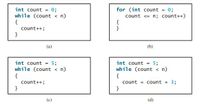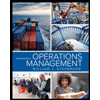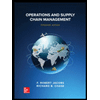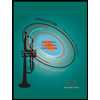
Practical Management Science
6th Edition
ISBN: 9781337406659
Author: WINSTON, Wayne L.
Publisher: Cengage,
expand_more
expand_more
format_list_bulleted
Concept explainers
Question
Count the number of iterations in the following loops:

Transcribed Image Text:= 0;
int count
while (count < n)
{
for (int count
count <= n; count++)
{
}
0;
count++;
}
(a)
(b)
int count
while (count < n)
{
= 5;
int count = 5;
while (count < n)
{
count++;
count = count + 3;
}
(d)
Expert Solution
This question has been solved!
Explore an expertly crafted, step-by-step solution for a thorough understanding of key concepts.
This is a popular solution
Trending nowThis is a popular solution!
Step by stepSolved in 2 steps

Knowledge Booster
Learn more about
Need a deep-dive on the concept behind this application? Look no further. Learn more about this topic, operations-management and related others by exploring similar questions and additional content below.Similar questions
- There are five things that are important to managing bottlenecks, which is the most important and why?arrow_forwardUp, Up, and Away is a producer of kites and wind socks. Relevant data on the bottleneck operation in the shop for the upcoming fiscal year are given in the following table Wind Socks 10,000 units/year Item Demand forecast Lot size Standard processing time Standard setup time Kites 32,000 units/year 25 units 0.4 hourlunit 3.0 hours/lot 70 units 0.8 hour/unit 40 hours/fol The shop works two shifts per day, 8 hours per shift, 210 days per year. Currently, the company operates four machines, and desires a 25 percent capacity cushion. How many machines should be purchased to meet the upcoming year's demand without resorting to any short-term capacity solutions? The number of additional machines required is (Enter your response rounded up to the next whole number)arrow_forwardTailwind, Inc., produces high-quality but expensive training shoes for runners. The Tailwind shoe, which sells for $210, contains both gas- and liquid-filled compartments to provide more stability and better protection against knee, foot, and back injuries. Manufacturing the shoes requires 10 separate tasks. There are 400 minutes available for manufacturing the shoes in the plant each day. Daily demand is 60. The information for the tasks is as follows: Performance Time Task Must Follow This Task ABCDEFGHI · Task (in minutes) А В Е Н 1 -324-325- - A B B C, D A F G E, H J 3 | Total 25 Required: a. Draw the precedence diagram showing the task precedence and their times b. Determine the cycle time associated with the rate of output required. c. What is the theoretical minimum number of work stations required to satisfy this output rate? d. Allocate the tasks to work stations taking into consideration the precedence requirements and using the LOT rule to break ties between feasible tasks.…arrow_forward
- Super Fun Industries manufactures four top-selling toys code-named A-148, B-356, B-457, and C-843. The following table shows how long it takes to process each toy through each required station. Note that all times are in minutes. Super Fun's manufacturing plant is open 12 hours a day, 5 days a week, and 8 hours on Saturday. b. If weekly demand for the four products are A-148=180 units, B-356=310 units, B-457=280 units, and C-843=300 units, which station is the bottleneck, and is it capable of producing all the toys demanded? The bottleneck for Super Fun Industries is ▼ Station 1 Station 2 Station 3 Station 4 , with a utilization of ______%. (Enter your response rounded to one decimal place.)arrow_forwardssarrow_forwardA local toy manufacturer is using a production line that runs 8 hours per day and produces a toy that requires a total of 7 tasks to be performed. The daily demand is 100 toys. Times of the tasks are 2.73, 2.01, 2.13, 2.0, 2.61,2.71, and 2.95 minutes for A, B, C, D, E, F, and G, respectively. However, due to the nature of the product there are precedence rules that must be observed. Such that Task A does not need any predecessors; task B requires task A to be completed. To start task C and task D, each require task B to be completed. Task C must be completed prior to stating task E. Task F needs both task D and task E to be completed. Finally, task G can start only once task F is completed.Given we apply the most remaining tasks rule for balancing the assembly line, with ties broken according to longest task time first, What will the estimated idle time in minutes for FOURTH workstation? Oa. 1.00 O b. None is the correct answer Oc. 0.06 O d. 1.85 O e. 0.09 S PAGE NEXT PAGE e here to…arrow_forward
- The trim line at PW is a small subassembly line that, along with other such lines, feeds into the final chassis line. The entire assembly line, which consists of more than 900 workstations, is to make PW's new E cars. The trim line itself involves only 13 work elements and must handle 20 cars per hour. Work-element data are as follows: Work Element A B C D E F G H I L M Time (Minutes) 1.8 0.4 1.6 1.5 0.7 0.5 0.8 1.4 1.4 1.4 0.5 1.0 0.8 Immediate Predecessor(s) None None None A A E B с D F, G H J I, K, L a. Draw a precedence diagram. b. What cycle time (in minutes) results in the desired output rate? c. What is the theoretical minimum number of stations?arrow_forwardA production process at Brianna Bryant Manufacturing is shown in the figure below. The drilling operation occurs separately from, and simultaneously with, the sawing and sanding, which are independent sequential operations. A product needs to go through only one of the three assembly operations (the operations are in parallel). 6 units/hr 2.5 units/hr Sawing Sanding Q Assembly 0.8 units/hr Welding 5 units/hr Assembly 0.8 units/hr Drilling 2.1 units/hr a) is the bottleneck. b) The bottleneck time is minutes per unit (round your response to two decimal places). c) The throughput time of the overall system is minutes (round your response to two decimal places). Assembly 0.8 units/hr d) If the firm operates 11 hours per day, 20 days per month, the monthly capacity of the manufacturing process is units (enter your response as a whole number).arrow_forwarda. what is the bottleneck of this process? b. what is the hourly capacity of the process?arrow_forward
- A medical equipment testing and calibration service is shown below. The customer usually brings the equipment to the service center. The service process requires service technicians to perform three process steps #1 to #3. Each technician is cross-trained so they can perform any of the three steps. The inspector does step #4 alone. After step #4, two parallel work activities are performed. That is, a shipping clerk packs the work (step #7), while simultaneously, a billing clerk prepares the invoice (step #5), and the customer is contacted by phone for pick-up (step #6). The average throughput is three equipment units per hour. The table below shows the work content of the process steps, activity times in minutes per unit, shared and non-shared work activities, and the type of resource required. There are three service technicians on duty, one inspector, one billing clerk, and one shipping clerk. Activity Time Activity Activity (minutes) Performed By Start - 1 7 Service…arrow_forwardA local toy manufacturer is using a production line that runs 8 hours per day and produces a toy that requires a total of 7 tasks to be performed. The daily demand is 100 toys. Times of the tasks are 2.73, 2.01, 2.13, 2.0, 2.61, 2.71, and 2.95 minutes for A, B, C, D, E, F, and G, respectively. However, due to the nature of the product there are precedence rules that must be observed. Such that Task A does not need any predecessors; task B requires task A to be completed. To start task C and task D, each require task B to be completed. Task C must be completed prior to stating task E. Task F needs both task D and task E to be completed. Finally, task G can start only once task Fis completed. Given we apply the most remaining tasks rule for balancing the assembly line, with ties broken according to longest task time first, What will the estimated idle time in minutes for THIRD workstation? O a. 1.00 O b. None is the correct answer 0.06 O d. 1.85 e. 0.09arrow_forwardWhich operation is the bottleneck of this process? a. Stocking b. Pricing c. Spotting d. Shipping e. Impossible to determinearrow_forward
arrow_back_ios
SEE MORE QUESTIONS
arrow_forward_ios
Recommended textbooks for you
 Practical Management ScienceOperations ManagementISBN:9781337406659Author:WINSTON, Wayne L.Publisher:Cengage,
Practical Management ScienceOperations ManagementISBN:9781337406659Author:WINSTON, Wayne L.Publisher:Cengage, Operations ManagementOperations ManagementISBN:9781259667473Author:William J StevensonPublisher:McGraw-Hill Education
Operations ManagementOperations ManagementISBN:9781259667473Author:William J StevensonPublisher:McGraw-Hill Education Operations and Supply Chain Management (Mcgraw-hi...Operations ManagementISBN:9781259666100Author:F. Robert Jacobs, Richard B ChasePublisher:McGraw-Hill Education
Operations and Supply Chain Management (Mcgraw-hi...Operations ManagementISBN:9781259666100Author:F. Robert Jacobs, Richard B ChasePublisher:McGraw-Hill Education
 Purchasing and Supply Chain ManagementOperations ManagementISBN:9781285869681Author:Robert M. Monczka, Robert B. Handfield, Larry C. Giunipero, James L. PattersonPublisher:Cengage Learning
Purchasing and Supply Chain ManagementOperations ManagementISBN:9781285869681Author:Robert M. Monczka, Robert B. Handfield, Larry C. Giunipero, James L. PattersonPublisher:Cengage Learning Production and Operations Analysis, Seventh Editi...Operations ManagementISBN:9781478623069Author:Steven Nahmias, Tava Lennon OlsenPublisher:Waveland Press, Inc.
Production and Operations Analysis, Seventh Editi...Operations ManagementISBN:9781478623069Author:Steven Nahmias, Tava Lennon OlsenPublisher:Waveland Press, Inc.

Practical Management Science
Operations Management
ISBN:9781337406659
Author:WINSTON, Wayne L.
Publisher:Cengage,

Operations Management
Operations Management
ISBN:9781259667473
Author:William J Stevenson
Publisher:McGraw-Hill Education

Operations and Supply Chain Management (Mcgraw-hi...
Operations Management
ISBN:9781259666100
Author:F. Robert Jacobs, Richard B Chase
Publisher:McGraw-Hill Education


Purchasing and Supply Chain Management
Operations Management
ISBN:9781285869681
Author:Robert M. Monczka, Robert B. Handfield, Larry C. Giunipero, James L. Patterson
Publisher:Cengage Learning

Production and Operations Analysis, Seventh Editi...
Operations Management
ISBN:9781478623069
Author:Steven Nahmias, Tava Lennon Olsen
Publisher:Waveland Press, Inc.